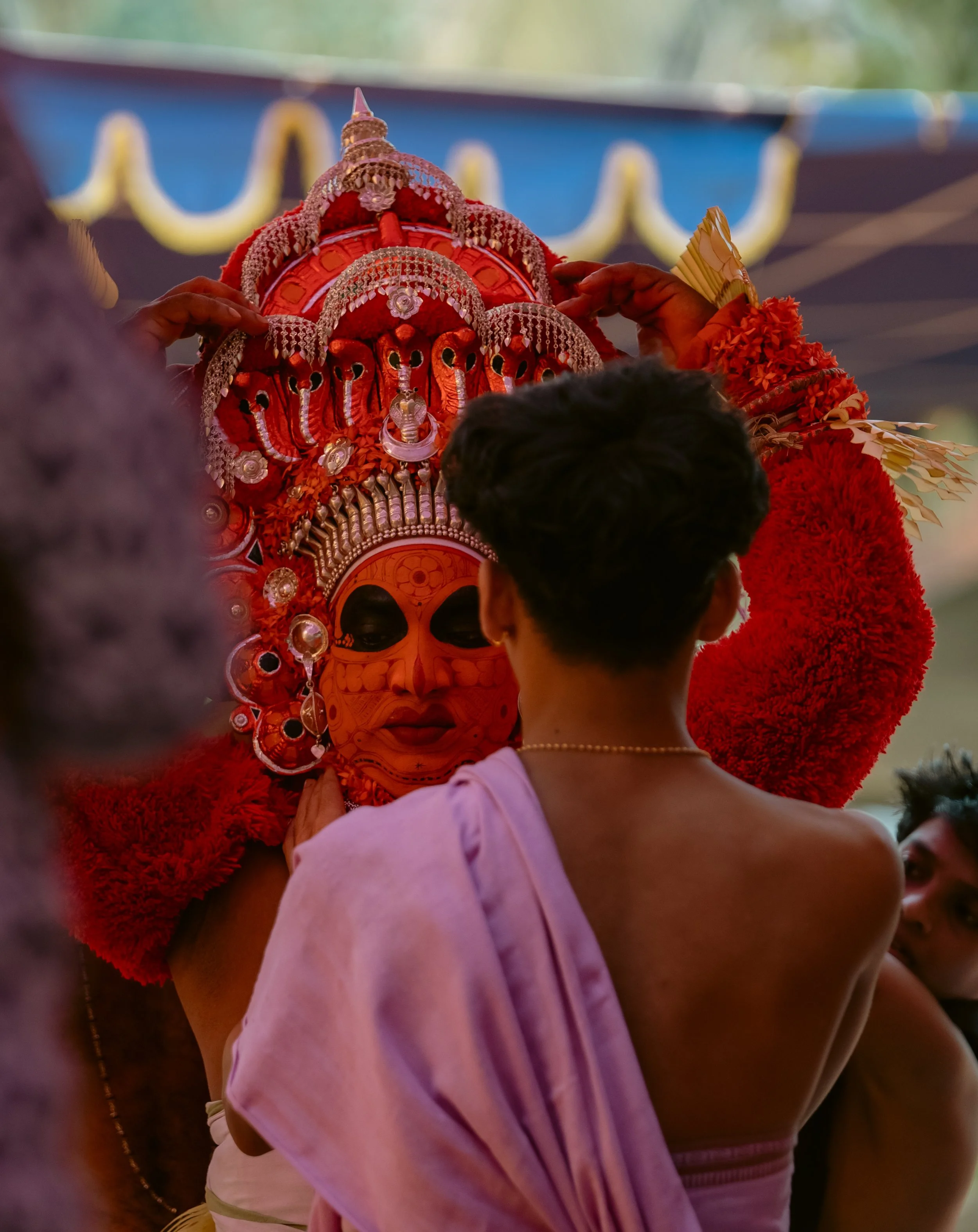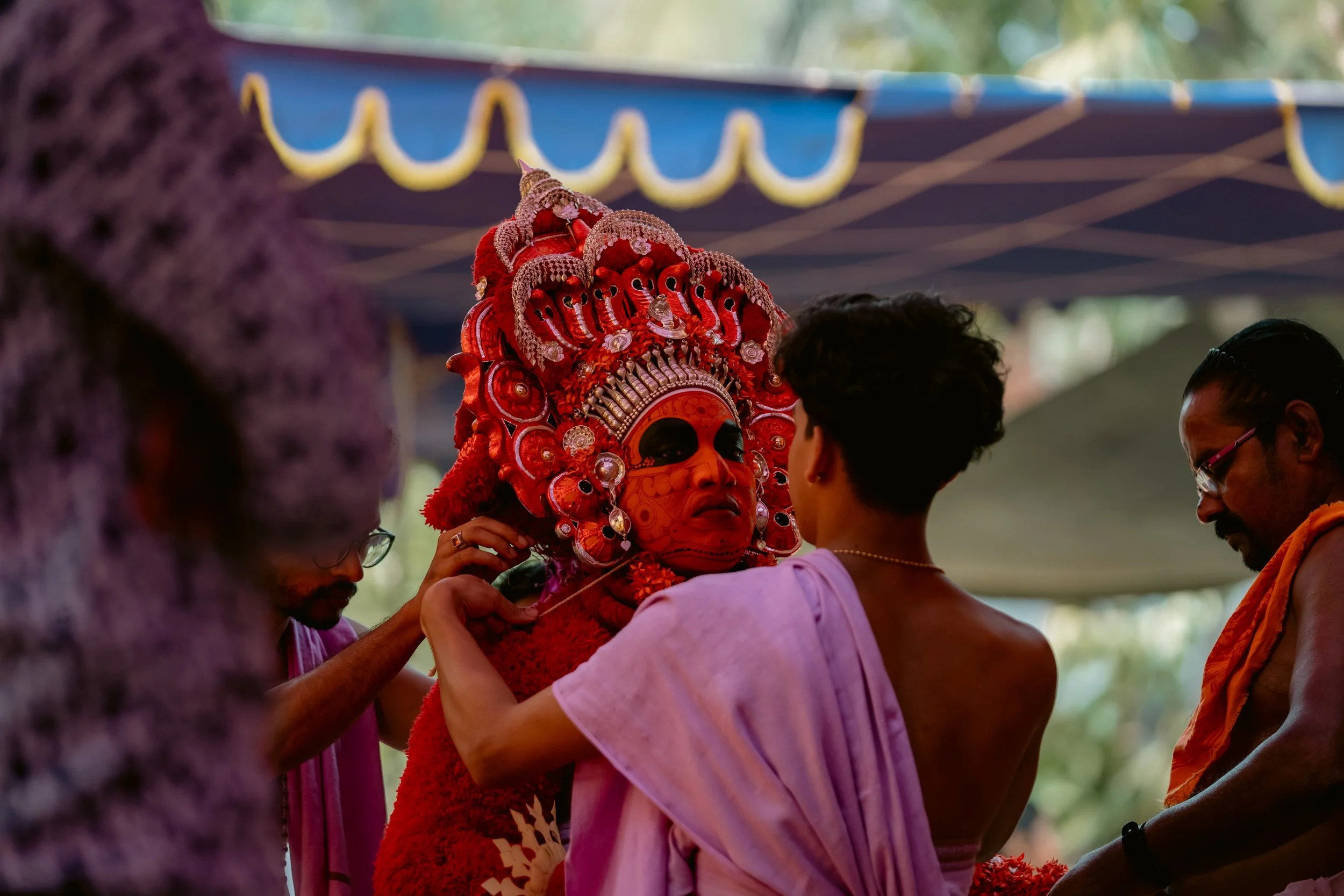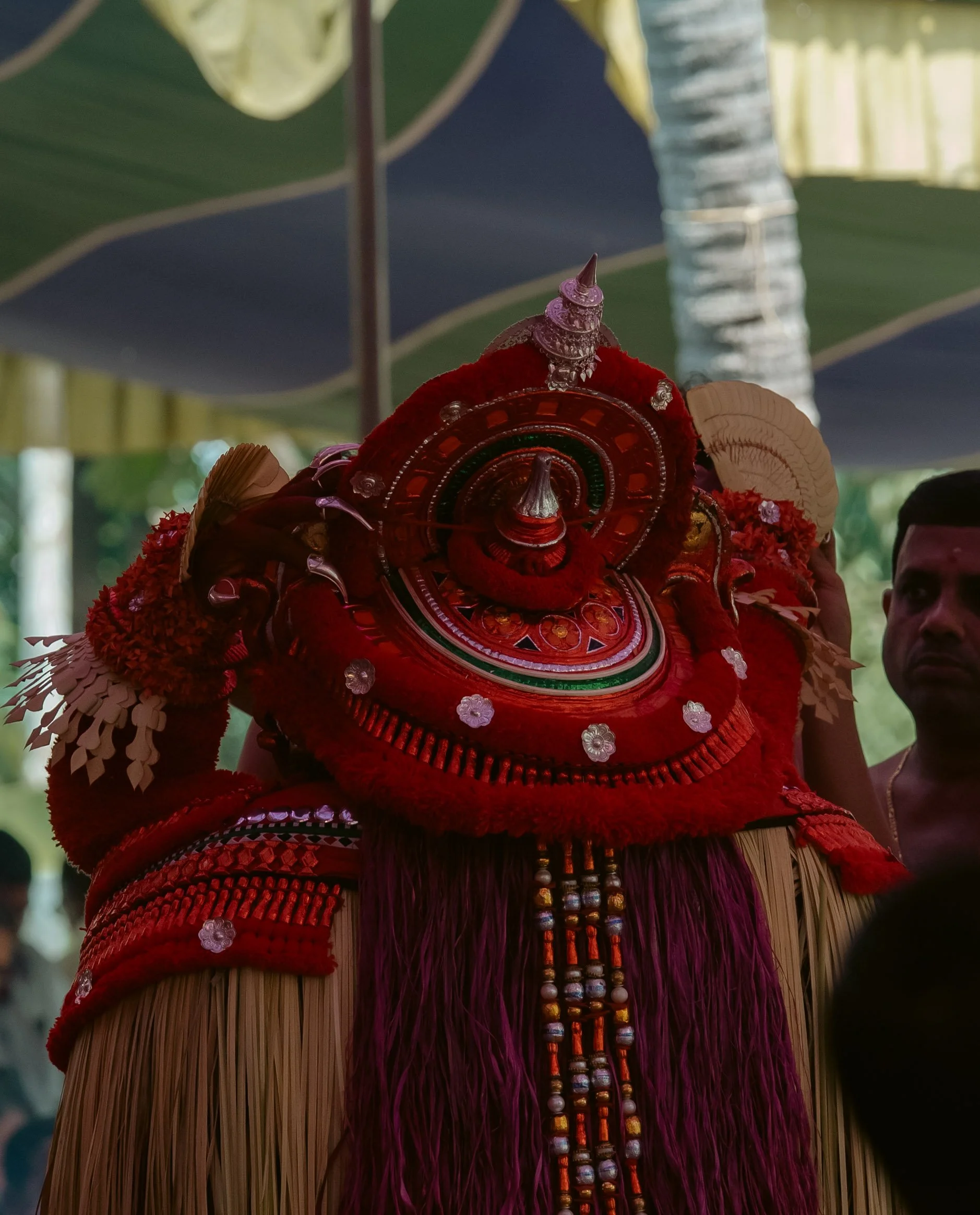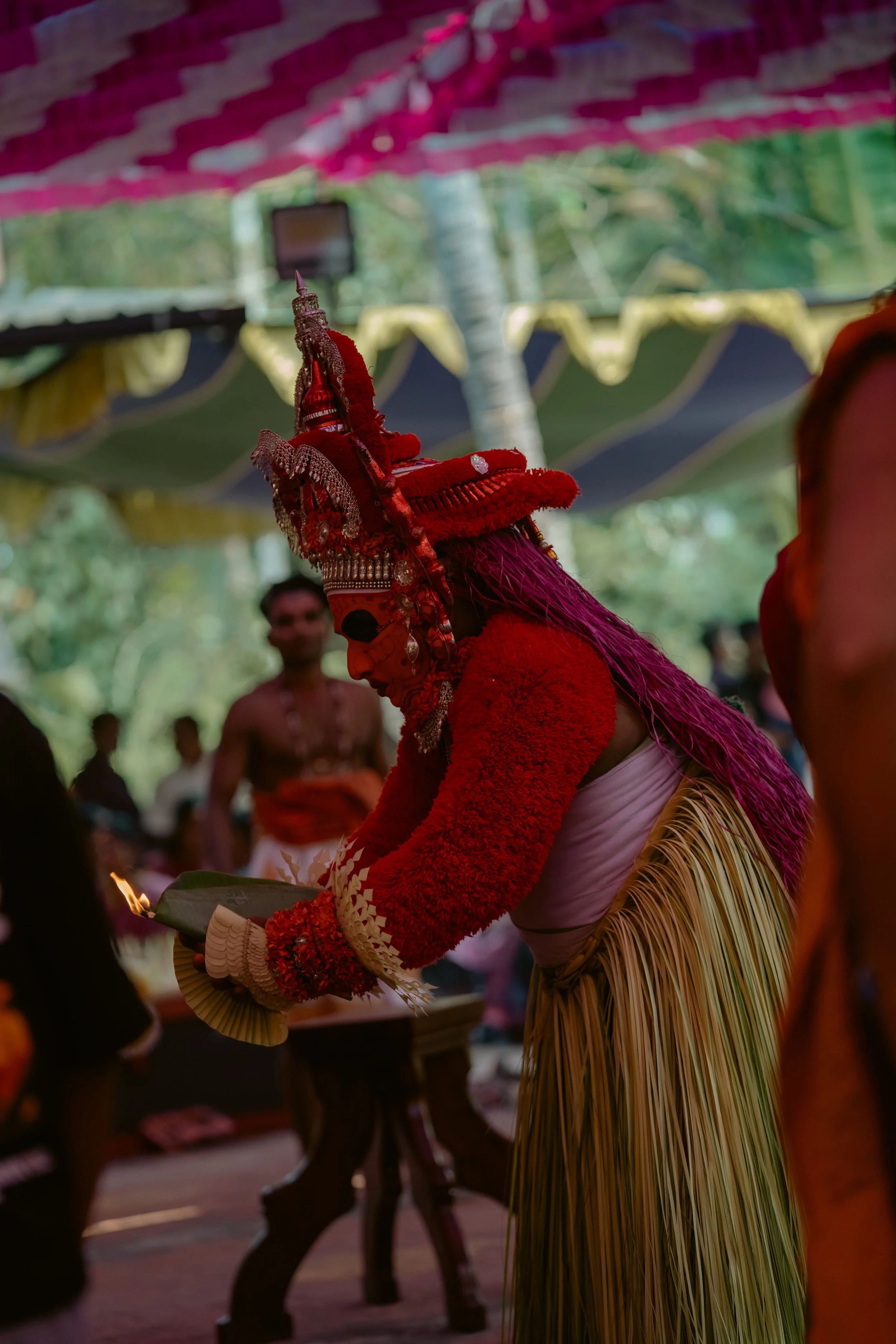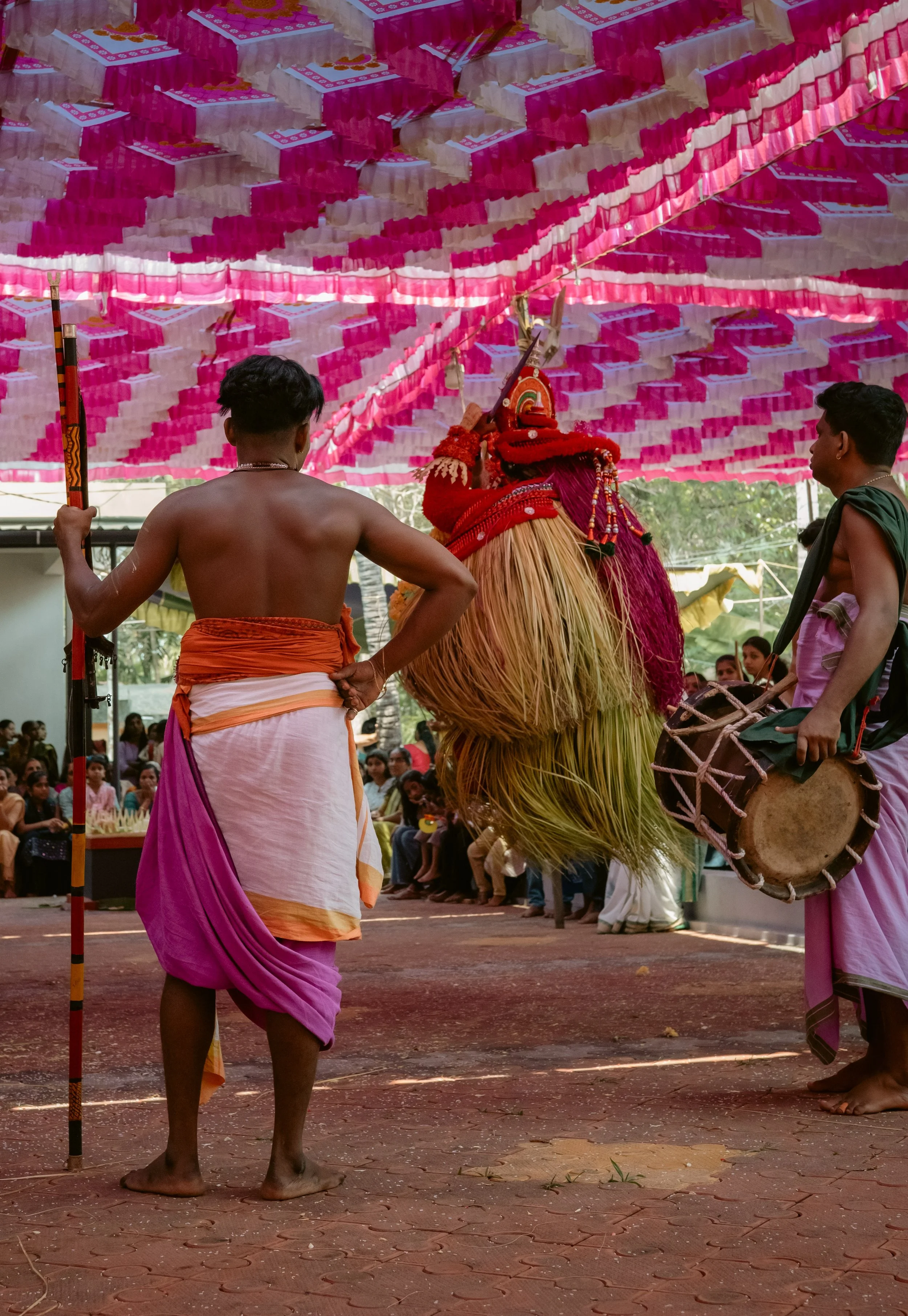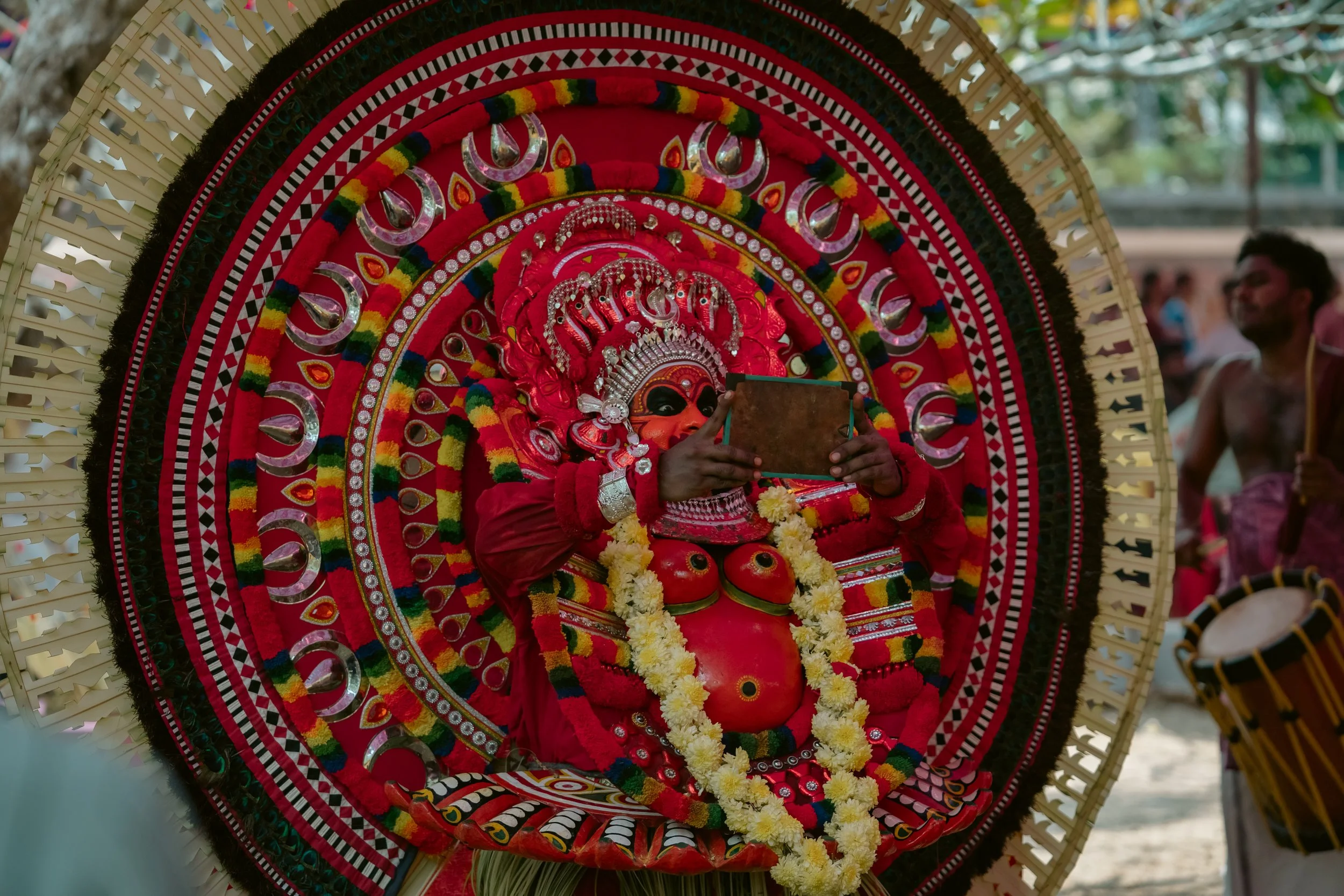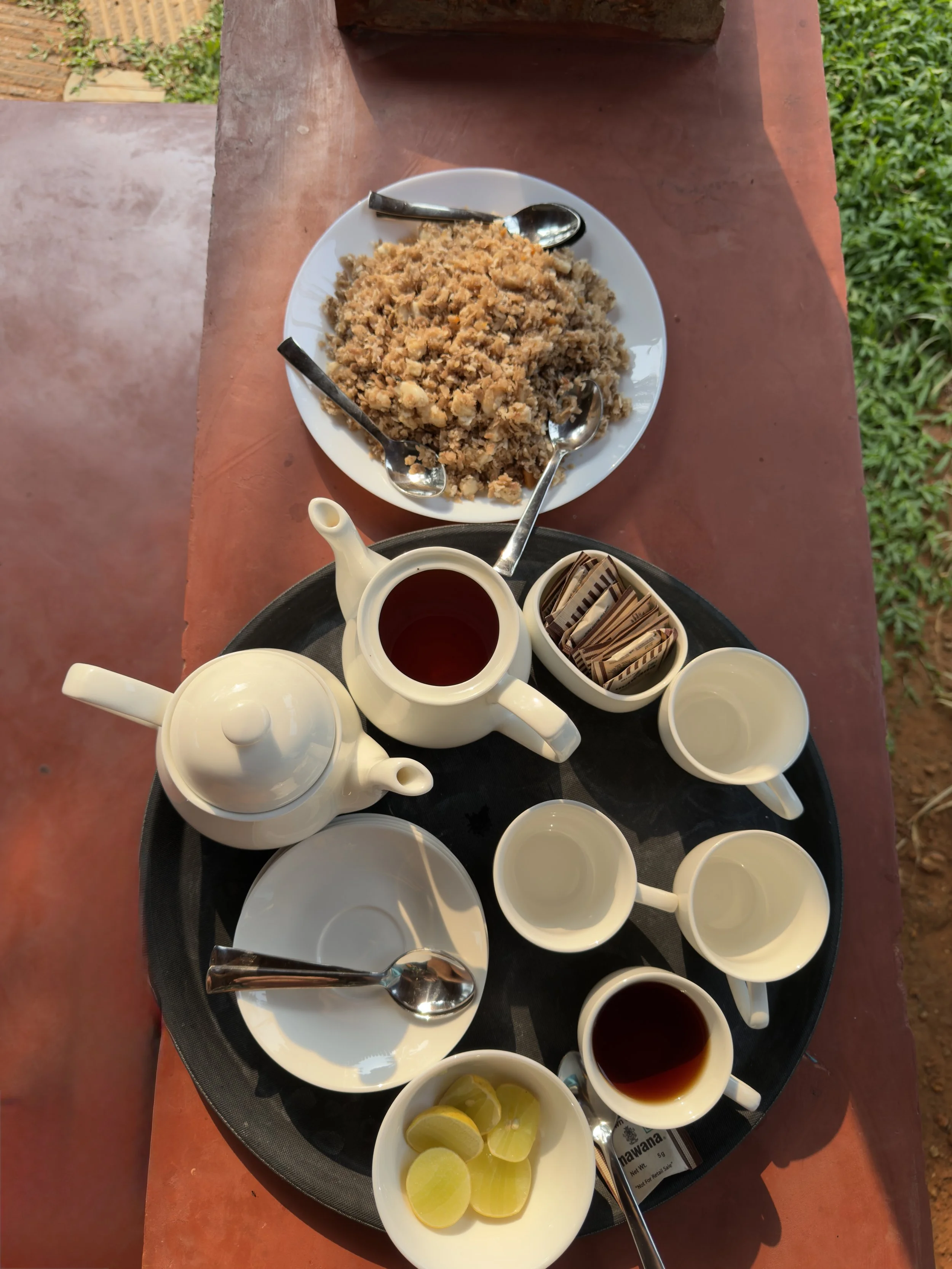Finding God in Kasaragod Part 2
Day 2 of our Theyyam interlude, dawned mild and pleasant. The sea hummed, like a host of extremely calm angels. As for us, we had an action packed day ahead. Though we initially planned to leave right after an early 7.30 breakfast, Sangeeth informed us that the programme was going to be a bit delayed. How propitious considering that we were toying with the idea of having some toddy. Though Sanish told us that we’d have to make an order the previous night, we thought we would try our luck in case. A request was made and lo, behold luck was on our side. Sanish managed to get hold of some toddy. And we got to begin our day with some fresh, sweet country alcohol. These are just a few things that made our Polika stay so “rooted”. Manoj chettan’s business partner came over to chat with us, to see how we were doing and if we were comfortable. He gave us a bit of local history, stories about the house and how it came to be. This lovely place was nearly torn down, and it took the vision of Polika to save it. If I had all the time in the world, I would have sat down and had a long conversation about Kasaragod, its history, its little industries and its delightful people.. But we had somewhere to be and so we quickly downed our fresh toddy (a whole plastic decanter of it). Fresh toddy is sweet and doesn’t have quite the kick the more fermented and aged version of itself has. It gave us a nice little buzz for the road.
Nileshwaram, the little locale of our Malabar escapade, is a revelation by daylight. A little jewel whose beauty is revealed when you travel by the smaller roads as opposed to the dusty half-constructed highway. A former seat of royalty, Nileshawaram was perhaps made solely to delight the gods. A poem of tranquil verdant lagoons with the dramatic lilt of terracotta rooftops and crimson-hued hillsides. Shrubs of the deepest green, hot red hibiscus peek from behind laterite bricked walls. Jade paddy fields glint as you race past, momentarily dazzling you with prismatic light. A line of communist flags bloom red in the middle of a stream, fluttering and rippling, occupying the aquatic and aerial domains at once. This coastline sings with the voices of ancients as legends blurs into history in the eternal embrace of the Arabian Sea. Verdant nooks, sacred groves, old homesteads that escaped time’s harsh gaze - a tapestry made of the finest weave, that can only be truly appreciated from a heavenly seat.
I found myself wanting to get acquainted with every old homestead, every sacred grove, every pond - their distinct personalities are such a defiance to the quick homogenising of all things. This place where multiple histories, multiple ethnicities and multiple languages came together to form a culture that is so lyrical, so full of stories that you want to just be on first name basis with this place. There’s an innate sweetness to the dialect and the people who speak it. There’s a kindness in their hospitality, born from centuries of welcoming people into their fold. Malayalee, Tulu, Konkani, Arab, Kannada, Marathi, Urdu influences contour the nuanced cultural landscape of this land. There is a tinge of old-worldness to their faith, as testified by the multitude of tharavadu kshetrams or ancestral temples that dot the roadside. This isn’t a culture I’m familiar with as a Kochite. These living dedications made to their ancestors, their culture and their faith, this permission to allow poetry some space - something in me responds to that. The bigness of faith - crowds, big places of pilgrimage, over commercialised gods - those make me want to run the other way. But these quiet, living sacred spots that meditate under the green darkness of shivering banyan leaves - that makes my soul bow in worship.
We arrived a bit early - arriving early means better seats and the chance to see the the koladhari prepare for the ritual. It takes a village to get them ready - from the people who help him get dressed, to the chenda artistes, to the karnavars walking around in typical karnavar mode. Now would be a good time as any to introduce you to the official term for the family elders, a clique that inevitably includes only men. The quintessential Karnavar walks around, looking extremely self-important, and rightfully so, because they also (in most cases) do a lot of the important work. Some of them walk around with “at ease” hands, officiated with a passive frown - so that they look like they’re doing something when they’re not really doing anything. The ones who actually have things to do, are upto their elbows in work, to actually leave their hands so indisposed.
Watching the koladhari slowly but surely embody the spirit of the deity is a fascinating business. One moment you’re marvelling at the intricate face make up - which does not run despite being made from natural materials like rice powder, turmeric, vermillion, etc, and the next you’re absorbing the minute details of their costume realising that history lives and breathes in your presence. A fine balance that could be tip over any time and all this could be lost. It’s one thing to see the whole spectacle and be amazed. But to see it being pieced, one painstaking detail at a time, to witness the “becoming” of a god, it’s truly like partaking in a sacrament. And when they look into the mirror, the man in them completely giving way to the god with each gaze, it’s terrifying and rapturous at the same time. Where does the soul go, when god enrobes himself in a man’s skin? How will the soul find its way back home? Gods are erratic “beings” - anything could happen. Also, there is that issue of rioting goosebumps driving you to distraction.
In all my years in advertising, I wondered how it was that Kannur produced so many art directors. Over 90% of the graphic designers worth their salt were from Kannur. And the answer might lie somewhere here. The fact that they are raised on a steady diet of visual brilliance. Malabar has its own design language, formed from robust portions of folklore, artistic expression, mystical nature and inspired, well-preserved architecture. Nature is generous if not always kind.
The next theyyam on the schedule was Vishnumoorthi and later, in the same venue, Rakthachamundi. Two violent avatars that wore their vengeance on their demon-blood splattered sleeves. Though day theyyam miss the dramatic theatre of night theyyams, one gets to focus on the finer details. Mysticism by day and by night are two different presences.
Vishnumoorthi is based on the legend of Narasimha and the vanquishing of Hiranyakashipu. A protective avatar of Vishnu who provides violent succour to his devotees. A local retelling of the story places Palanthai Kannan, a devotee of Vishnu in the centre of the story and an upper caste villain in the form of Kuruvat Kurup. When Kuruvat Kurup’s people brutally murder Palanthai Kannan, it’s Lord Vishnu who mets out justice. Showing that this god isn’t exclusive to his “upper" caste” devotees. That higher born didn’t mean a free pass when it comes to moral conduct or mortal sins.
At the end of the ritual, we stood in line for our blessing. Along with generic blessings, he added one that thoroughly gutted me. “Do all things well and WITHOUT LAZINESS.” I felt so attacked.
How are you supposed to feel when god calls you out on your laziness? And that too a god whose claim to fame is disembowelling the asura that pissed him off.
Pretty true to form, went right for the gut.
The second theyyam was Rakthachamundi - a fierce avatar of Goddess Durga who protected the world from a demon whose every drop of blood spawned another demon. Vanquishing such a demon proved to be tricky business, so it was upto Rakthachamundi to drink every drop of blood. To absorb the evil to save this undeserving world. This particular koladhari, unlike the previous one, sat all by himself putting on his makeup and preparing for the ritual. The fact that could be some unpleasant undercurrents of truth, regarding caste dynamics, behind this, left a rather sour taste in my mouth. My upbringing in 90’s Kochi was quite egalitarian and secular, where we mixed quite freely and most of us kids regarded god as a vague inconvenience and “mandatory exam preparation” . Most of us kids had the same “tolerance” for our respective religious obligations and we moved in and out of each others’ homes quite freely. Looking back, I recognise that it was a privilege that I took for granted.
Meanwhile Raktachamundi continues to save this undeserving earth. Some times during the ritual, the human appears, parched and needing a sip of water. And once this base need is met, the goddess instantly takes over. In the sweltering heat and other undefined obstacles, it takes a lot of otherness to move like a goddess would.
We stopped for lunch at a little place run by women chefs or chechis as we lovingly address them. I love these little places - these little movements that are veritable minor earthquakes, in the feminist movement. Women using their cooking skills to eke out a living by doling out homely food in an unpretentious setting - they shake up a system so entrenched in denying women financial independence. The quintessential hapless woman who stops wringing her hands and puts them to better use by turning the “a woman’s place is in the kitchen” patriarchal system on its head. That’s the stuff of legends.
Chechi, a word that directly translates to older sister, but often used to respectfully address a female stranger, without the formality of madam. These chechis they bustle around in nighties - the unofficial-official garb of the busy Malayalee homemaker - teasing you volubly as you ask for a smaller portion of rice, cajoling you to another portion of kootan (vegetable sides) and asking if you’d like one more fried fish. I love how they fuss over you - like you’re a guest at their place. We reached a little late (3 pm) and they were out of most of the fun fish. But nevertheless, we had a really delicious lunch and headed back to Aavi for some much needed siesta. Siesta accompanied by the lullaby of the waves. Life can be extremely kind some times.
As someone who takes their siestas very seriously - a siesta connoisseur if you will - I would rate that siesta a full ten. It was magic. Nap time, mellifluous waves, soft beach breeze, dappled light filtered down by palm leaves and the knowledge that the sea is near. To wake up and stumble out, half groggy, to a golden evening and have the Arabian Sea wave at you - paradise has to fight hard to compete or compare. I’m a massive sucker for my home state and home sea. Imagine having a nice little verandah to sit, with the cool of red oxide beneath your tush, and sounds of the wind, waves and some overenthusiastic crow pheasant or crow. And then Sanish, now an envoy from your grandmother’s kitchen, brings you a plate of aval (beaten rice) with pazham (banana) dusted with sugar and yes, chaaya (tea). The three Malayalees in our foursome, ate our tiffin with misty eyes and hearts that had wandered into three respective kitchens. Both my grannies, Sahit’s Amma and Sapna’s mum had definitely joined us there. Tea time with our angels.
Here’s a word of advice, when you’re at Aavi - your tea time shenanigans might begin to give you ideas about your stomach capacity. It might try to convince you that you’re this delicate, waist-watching, appetite like a bird kind of dainty darling who could not get past two morsels for dinner.
No.
Do not listen. Especially if biriyani is on the menu. Trust me, all the mysteries of deep space and black holes cannot begin to compare with the inexplicable things your pie hole and stomach become when faced with good ol’ Kerala cuisine. I don’t know if it’s the weather or the proximity to the sea or just plain gluttony - but you will regret the moment you mentioned the word “share”, once you’ve had the first mouthful.
Dinner WAS in fact prawn biriyani - yet another Malabari masterpiece. AND crab curry. Divine, delicious fresh crab curry. Our eyes flashed with understanding - rather than pile one pleasure over another and do little justice to both, we thought we’d ask them to save most of the crab for next morning’s brekkie. The brainwave was of tidal proportions. .
We were to leave for the last and most dramatic theyyam around 2.00 am. The location was around 50 km away, in Kannur and we had to make sure that we got there in time. This was the hugely popular Kandanarkelan - and we were bracing for crowds. Can you imagine that - we were expecting crowds at 3 am. In a small town, people stay up and have been going from village to village in the pitch dark, long before vehicles and street lights, to partake in this ritual. Isn’t that something?
There is a certain viscosity to the dark in North Kerala. A dark made for phantoms. A dark I’m quite unfamiliar with. Kochi was never a “small” city for a memory that began to form in 1983. It was never small enough this thickness of dark. Dark is texturised by tones of the paranormal, hued by the wispy smokes of otherness, dark that is somehow even “more dark” under the incompetence of the halogen halos of village street lights that punctuate the streets that lead to hearths and haunts.
It’s a kind of dark that sits on tops of trees and watch as your car with its flailing headlights that try to cut a passage ahead. As for you, you feel its eyes on you. And you wonder about the people of this land. If they don’t scare easy. If they have myth and legend so ingrained into their DNA that there is a bit of laterite dust in the constitution of their blood. Literally children of the soil. Born of the soil.
There is some mystery yet, in walking through the village paths, with their hip-level red walls, beyond which elephant ear leaves, stood grim and tall, like a spear tip or an ace of spades. To see smoke stream from a small descent, a thickly-manned hollow. And yet, people were going the wrong way. Someone said in the passing “What’s the point of going now?” Something was amiss.
Kelan called us.
And we went.
On a night with a moon-shaped gash in the sky. A bloodied druid’s sickle bearing testimony to a fearsome battle. A broken demoness tooth. Or was it be an elongated nail? Red and smoking with the wrath of evil cut short. Embers from a fire stoked by dreams. The stuff epiphanies are made of. The kind of night made for magic.
Not the kind of night when you expected to miss your date with destiny. To be disappointed. After all, fate sanctified the night with these portentous signs. But we did. We got the timings wrong.
Not once.
Twice.
On the same night.
And missed Kandanarkelan’s fiery transformation. Into a god who walked through fire. It was myth made flesh. Legend born and breathing. It was defiance made incarnate.
And we missed it.
But this was a night for the sublime divine, wasn’t it? It wasn’t made for the dank metallic aftertaste of disappointment. For knuckles rapped for tardiness. It was until it wasn’t.
Now that I look back, it was a night for focusing on the details. The spell of a bleeding sky, of night air that trembled to distant chorus of the chenda. Of half-running through red-dust covered village paths, mad with expectation. Of a clanking anklet that would, for evermore, echo in the dark corridors of our dreams. Of a distant howl as man became god. Of hearing him before you saw him. Of sharing a moment, unlike anything you have so far, with your friends. Of catching a god’s shadow in the tree canopy above you. Of being terrified of looking beyond that veritable blessed lakshmanrekha, for fear of seeing what prowled beyond the perimeter of this hallowed ground. Of, the eclipse of disappointment shifting and finally dawning, seeing and knowing that you are blessed. A living, warm-blooded, breathing benediction.
Because you’re here.
Finally. Fulfilling a long-dreamt dream. Grasping, holding, experiencing a moment that long evaded you.
Knowing that you’re summoned. Again. That you should return.
And you would.
Because he called you. Again.




